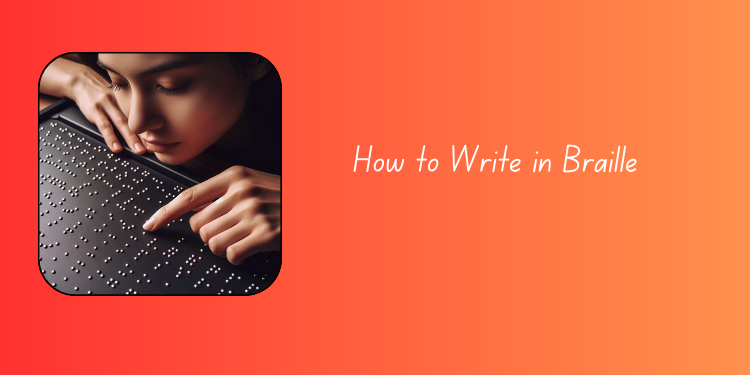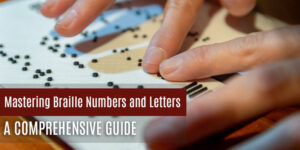Introduction
Braille is not just reading material; it can also be written. It’s great to know that you have the same query of how to write in Braille. Hence, we welcome you all to this blog, where we will discuss the same.
Whether you are new to writing Braille for yourself or interested in adding it to your technological skills, this blog will introduce the basics of writing Braille and how it works. So, keeping things fun and easy-going, let’s proceed.
Why Learn Braille?
In an age dominated by screens and voice controls, learning Braille may seem unnecessary. However, knowing this ancient form of writing keeps language skills sharp and infuses independence through simple labeling and note-taking tasks.
1. Improve Literacy
Dependency on audio can deteriorate the quality of grammar and spelling skills, while Braille can maintain these essential abilities while providing deeper comprehension of text structures like headings and lists.
2. Speed and Efficiency
Braille typing can help individuals with faster writing by using contractions. The short forms of Braille represent individual words or phrases – than standard writing systems do.
3. Tech Integration
The advanced electronic Braille typewriters connect seamlessly with devices, providing visually impaired people with better ways of engaging with technology.
4. Practical Applications
Braille has numerous practical applications in everyday tasks that promote independence and should be included in daily life. From labeling kitchen containers to leaving reminder notes for yourself, Braille helps make everyday tasks simpler while supporting self-sufficiency.
Braille Basics: Understanding the Alphabet
Contrary to popular belief, Braille is not a language but a code developed by Louis Braille in 1824. It is designed as a logical and systematic alphabet-based code system, making learning the alphabet relatively straightforward. Each Braille character, called a cell in Braille lingo, consists of up to six dots arranged in a 3×2 grid for easy reading/writing in Braille. Writing in Braille begins by understanding this cell structure before you start writing in Braille yourself!
Tools for Writing in Braille
To start writing in Braille, you must possess all of the appropriate tools. Below is a breakdown of essential equipment:
Slate and Stylus
This pair works much like pen and paper. The slate guides dot placement while the stylus embossed dots onto thick Braille paper. Writing from right to left allows text to be read from left to right when flipping the page over.
Braille Typewriter
Mechanical tools like the Perkins Brailler are known for making writing more accessible and quicker, offering reliable results with minimal effort required from users. These durable mechanical devices provide ease of use as well as durability.
Braille Printers (Also Called Embossers )
These printers connect directly to computers and print Braille text from digital documents – perfect for creating Braille from large volumes of text.
Electronic Braille Devices
Modern technology includes electronic Braille keyboards that provide auditory feedback to improve learning, as well as integration with smart devices for everyday tech use.
Investment in Braillewriter is a significant decision for someone serious about learning Braille writing. A Braille writer offers both beginners and more experienced users an accessible, tactile way of practicing and improving Braille literacy.
Implementing Modern Technology
A significant advancement in Braille literacy includes using electronic Braille keyboards. These devices provide immediate auditory feedback and can connect to smartphones and computers, turning every text entry into an opportunity for learning.
Practical Tips for Acquiring Braille
a. Learn with Others
Participate in an educational community or find a study partner. This can make the experience of learning Braille much more pleasurable.
b. Use Braille in Everyday Situations
Take the plunge into everyday situations, such as labeling items around your home or reading Braille labels at stores.
c. Stick with Your Routine
Consistent practice is more beneficial than intermittent study sessions. Set aside time each day to read and write Braille.
d. Be Patient
Take time to adjust to Braille’s tactile nature. Though different from conventional reading and writing, it will become an integrated part of your daily life with time.
Finding Resources
Numerous organizations and online platforms are providing Braille learning resources. In the US, resources like Braille Music and More for the Blind provide invaluable support. At the same time, many other international organizations for the Blind and Visually Impaired offer valuable services. In addition, various tools and applications have been developed that help practice Braille anytime, anywhere.
Conclusion
Beginning your journey of Braille literacy can open up a world of communication and independence. From personal enrichment to improving technological interactions, learning to type Braille offers lasting benefits.
Delve into making Braille on paper to explore its many doors; every expert started somewhere! Remember that every beginner began somewhere – stay curious, keep practicing, and never give up! For further assistance or resources, reach out to Braille Music and More.
Happy writing in Braille!
You Can Also Read Our Other Blogs
- Top 10 Fascinating Facts About Braille
- Breaking Down Barriers: Is Braille Hard to Learn?
- 4 Ways Learning Braille Can Be Fun and Games
- The Creativity in Braille: Art for the Visually Impaired
- The Importance of Braille in Today’s World
- The Impact of Braille Menus in Restaurants
- 12 Things You Probably Don’t Know About Braille
- Contracted (Grade 2) Braille Explained
- 12 Things You Probably Don’t Know About Braille
- Empowering Braille Literacy Through Digital Content







